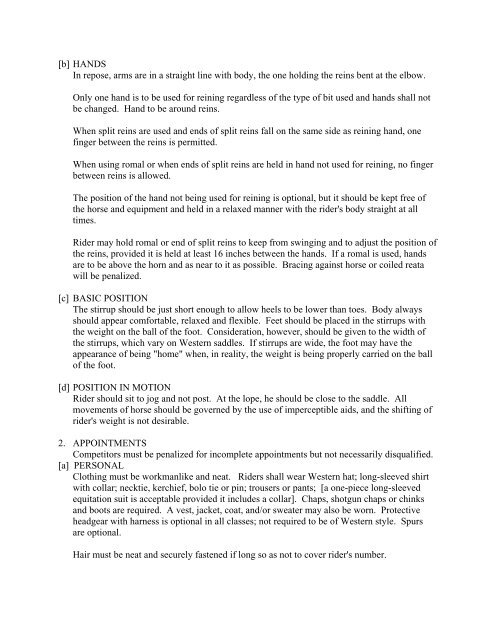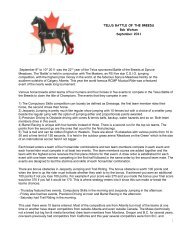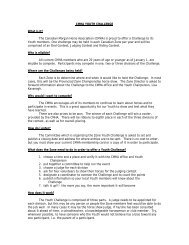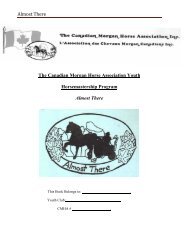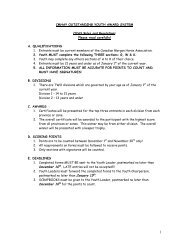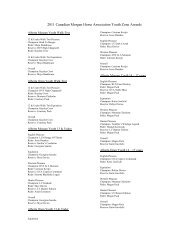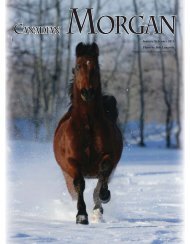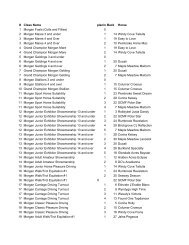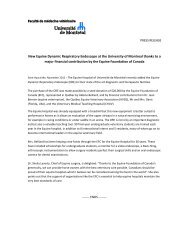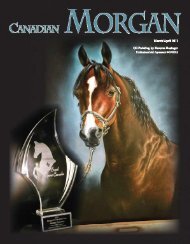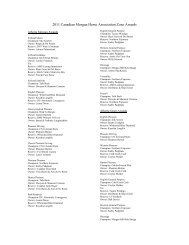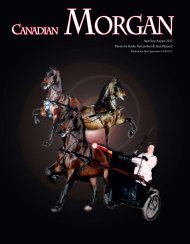Canadian Morgan Horse Association Incorporated CMHA MEDAL CLASS RULES
CMHAY Medal Class Rules - Canadian Morgan Horse Association
CMHAY Medal Class Rules - Canadian Morgan Horse Association
You also want an ePaper? Increase the reach of your titles
YUMPU automatically turns print PDFs into web optimized ePapers that Google loves.
[b] HANDS<br />
In repose, arms are in a straight line with body, the one holding the reins bent at the elbow.<br />
Only one hand is to be used for reining regardless of the type of bit used and hands shall not<br />
be changed. Hand to be around reins.<br />
When split reins are used and ends of split reins fall on the same side as reining hand, one<br />
finger between the reins is permitted.<br />
When using romal or when ends of split reins are held in hand not used for reining, no finger<br />
between reins is allowed.<br />
The position of the hand not being used for reining is optional, but it should be kept free of<br />
the horse and equipment and held in a relaxed manner with the rider's body straight at all<br />
times.<br />
Rider may hold romal or end of split reins to keep from swinging and to adjust the position of<br />
the reins, provided it is held at least 16 inches between the hands. If a romal is used, hands<br />
are to be above the horn and as near to it as possible. Bracing against horse or coiled reata<br />
will be penalized.<br />
[c] BASIC POSITION<br />
The stirrup should be just short enough to allow heels to be lower than toes. Body always<br />
should appear comfortable, relaxed and flexible. Feet should be placed in the stirrups with<br />
the weight on the ball of the foot. Consideration, however, should be given to the width of<br />
the stirrups, which vary on Western saddles. If stirrups are wide, the foot may have the<br />
appearance of being "home" when, in reality, the weight is being properly carried on the ball<br />
of the foot.<br />
[d] POSITION IN MOTION<br />
Rider should sit to jog and not post. At the lope, he should be close to the saddle. All<br />
movements of horse should be governed by the use of imperceptible aids, and the shifting of<br />
rider's weight is not desirable.<br />
2. APPOINTMENTS<br />
Competitors must be penalized for incomplete appointments but not necessarily disqualified.<br />
[a] PERSONAL<br />
Clothing must be workmanlike and neat. Riders shall wear Western hat; long-sleeved shirt<br />
with collar; necktie, kerchief, bolo tie or pin; trousers or pants; [a one-piece long-sleeved<br />
equitation suit is acceptable provided it includes a collar]. Chaps, shotgun chaps or chinks<br />
and boots are required. A vest, jacket, coat, and/or sweater may also be worn. Protective<br />
headgear with harness is optional in all classes; not required to be of Western style. Spurs<br />
are optional.<br />
Hair must be neat and securely fastened if long so as not to cover rider's number.


